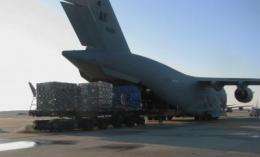The TacSat-4 ensemble is readied at Andrews Air Force Base for transport aboard a C-17 Globemaster to Kodiak, Alaska. This C-17 is based in Elmendorf, Alaska and operated by the 3rd and 176th Wings of the USAF. Credit: US Naval Research Laboratory
Naval Research Laboratory spacecraft personnel make final preparations to ready the TacSat-4 spacecraft for a May 2011 launch. Transported March 1, to the Kodiak Alaska airport via an Air Force C-17 and trucked to the Alaska Aerospace Kodiak Launch Complex, the TacSat-4 satellite will be launched aboard an Orbital Sciences Minotaur-IV launch vehicle into a highly elliptical orbit (HEO) with an apogee of 12,050 kilometers.
TacSat-4 is a Navy-led joint mission managed by the NRL Naval Center for Space Technology. The mission of TacSat-4 is to experiment with new satellite communications (SATCOM) techniques, augment current SATCOM capabilities, and advance the development of Operationally Responsive Space (ORS) systems for improved responsiveness of space capabilities.
TacSat-4 augments current SATCOM by providing communications-on-the-move (COTM) for existing radios without requiring antenna pointing and providing 10 Ultra High Frequency (UHF) channels that can be used for any combination of communications, data ex-filtration, or Blue Force Tracking — a system that provides military commanders and forces with location information about friendly military forces.
TacSat-4 provides flexible up and down channel assignments, which increases the ability to operate in busy, and sometimes restrictive, UHF environments. The unique orbit of TacSat-4 also augments geosynchronous SATCOM by providing near global, but not continuous, coverage to include the high latitudes.
"The ability to provide communications on the move without having to stop and point a SATCOM antenna was the most important user requirement and one which drove the design of the system," said Mike Hurley, section head, NRL Spacecraft Development.
The NRL Blossom Point Ground Station provides the command and control for TacSat-4 and maintains its user Virtual Mission Operations Center (VMOC) tasking system, allowing dynamic reallocation to different theaters worldwide and enabling rapid SATCOM augmentation when unexpected operations or natural events occur.
Provided by Naval Research Laboratory






















